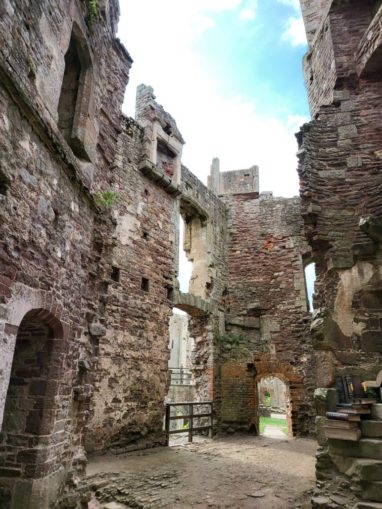History of the castle
Raglan Castle (or Castell Rhaglan if you speak Welsh) is situated to the north of the village of Raglan in the county of Monmouthshire.
The site has been used a defensive position for centuries, possibly as early as the Norman invasion of Wales. The current Raglan Castle was begun by Wlliam ap Thomas, the son of a minor Welsh family who rose through the ranks of politics in the 15th century. The basic shape of the castle was formed at this time, although most of it was later built over. The castle was framed by parkland containing deer, orchards and fish ponds.
By the 17th century the castle had passed on to Henry Somerset, the 5th Earl of Worcester, who lived a life of relative luxury, the interior of the castle being adorned with rich tapestries and other fine items well beyond the reach of the majority of the population. Henry developed the entrance route to the castle, including building the Red Gate.
During the First English Civil War the defences of the castle were improved with the addition of earthwork bastions, additional cannon, and a larger army of men, however this wasn’t enough to stop the Parliamentary forces, led by General Fairfax, taking control of the castle from Henry (who by then had been promoted to be the first Marquess of Worcester). Fairfax ordered the castle to be destroyed, however, the fortifications proved to be too strong and only a few walls were torn down.
By the time of the Restoration of Charles II, the Somerset family had managed to recover most of their possessions, including Raglan Castle and for the first half of the 18th century, the castle continued to deteriorate, with the Somerset family allowing their stewards to quarry stone from the castle for the repair of other estate buildings. In 1756, Henry Somerset (the 5th Duke) put an end to this practice and the castle became a tourist attraction.
The Great Hall was temporarily re-roofed in the 1820s, when the castle was used for a “Grand Entertainment” by the Somersets, and in 1830 Jeffrey Wyattville was employed to reinstate the Grand Staircase. In 1938 Henry Somerset, the 10th Duke, entrusted guardianship of Raglan Castle to the Commissioner of Works and the castle became a permanent tourist attraction. Today, the castle is classed as a Grade I listed building and as a Scheduled Monument, administered by Cadw.
Our trip there
One of two Puffins may recall my article on our trip to Aberystwyth and our brief trip to Raglan castle on route. The following pictures represent some of those taken on the day.












© text & images Reggie 2023



